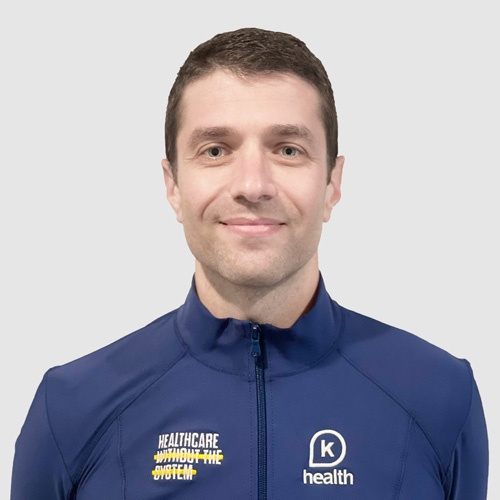We’ve all experienced the common cold and its unwelcome symptoms. Whether you’ve suffered from a runny or stuffy nose, sore throat, or non-stop sneezing or coughing, you’re not alone in your misery. With Americans suffering from 1 billion colds a year, it’s worth taking a closer look at the causes, symptoms, and varying stages of the common cold. Perhaps getting a better understanding of colds can help lower our chances of catching them.
What Is the Common Cold?
The common cold is one of a group of infections called viral upper respiratory infections or URIs. These infections happen when a virus enters your body through your mouth, nose, or eyes. The result is an illness that affects part or all of your upper respiratory tract, including the throat, nose, larynx, and sinuses. As we’ll discuss in more detail below, cold symptoms may include sore throat, coughing, runny nose, congestion, sneezing, headache, and low-grade fever.
What Causes a Cold?
Unlike the name suggests, being outside in cold or rainy weather won’t necessarily make you catch a cold. If anything, being inside, surrounded by and in contact with other symptomatic people, will. This is because there are many different types of cold viruses, and most are very contagious.
A cold virus can spread through droplets of saliva or mucus that gets released into the air when an infected person sneezes, coughs, or even talks. The cold virus can also spread by hand-to-hand contact with someone who is infected or by sharing contaminated objects, like towels, phones, toys, computer keyboards, or utensils. You’ll likely catch a cold if, after such exposure or contact, you touch your eyes, nose, or mouth without first washing your hands. This explains why adults suffer from 2-3 colds a year and children suffer from 5-7 colds per year, according to the CDC.
As we mentioned earlier, there are many different types of viruses that cause the common cold. In fact, more than 200 cold-causing viruses have been identified. The most common ones are from the rhinovirus family of viruses. Rhinoviruses, which contain at least 100 distinct virus types, are responsible for 40-50% of all colds. These culprits are usually most active in early fall, spring and summer.
Other virus families that cause colds include:
- Coronavirus
- Respiratory syncytial virus
- Adenovirus
- Human parainfluenza viruses
Since many different types of viruses can lead to cold symptoms, it has not yet been possible to develop a vaccine to prevent the common cold.
Cold Symptoms
Cold symptoms tend to surface 1-3 days after being exposed to a virus that causes colds. Signs and symptoms vary from person to person, as does the degree to which they’re felt and how long they persist. They might include:
- Runny or stuffy nose
- Sore throat
- Coughing
- Hoarseness
- Sneezing
- Congestion
- Headache
- Slight body aches
- Low-grade fever
- Generally feeling ill
- Thicker nasal discharge that is yellow/green in color
A rule of thumb is that if you are symptomatic, you are contagious. That being said, a person can start being contagious a day before any cold symptoms present themselves. People are most contagious during the cold’s first 24 hours; they usually remain contagious for the duration of the symptoms.
As symptoms of the common cold are similar to those of the flu, it can be hard to differentiate between the two. This is especially true since both illnesses spread around the same time of year. However, here’s how they differ: In general, flu symptoms (cough, sore throat, runny or stuffy nose, muscle aches, headaches, fatigue) are worse than those of the common cold and can include a high-grade fever and/or chills. If you have the flu, it’s worth seeing your doctor, as you can develop serious complications and may need antiviral drugs.
Typical Stages of a Cold
Colds typically last between 7-10 days. It typically can be broken down into three stages: early (days 1-3); active or peak (days 4-7) and late (days 8-10). The stages don’t necessarily matter, as once you have a cold, there’s not much to do but to wait it out.
- Days 1-3: During these first few days, typically around 50% of patients will show signs of a tickly or sore throat as their first symptom. This tends to happen because sore throats can occur as early as 10 hours after infection. What follows can be congestion, a runny nose, and sneezing, as well as fatigue and body aches. Coughing and hoarseness can also occur.
- Days 4-7: Symptoms typically peak in their intensity during this time. Your entire body may hurt, and your nose and eyes may be running non-stop. You may even have a fever, as it’s your body’s natural way to defend its compromised immune system.. If the fever is higher than 102° F (38.9°C), then it’s worth calling your doctor.
- Days 8-10: This is usually when your cold is winding down and wrapping up. If your symptoms have subsided, you are free and clear. However, if you’re still feeling under the weather, your condition is worse, or your fever returns or keeps rising, it may be time to see your doctor. Keep in mind that 25% of people experience a nagging cough that can last for as long as 18 days after their cold goes subsides.
Remember that no matter the stage, if you’re experiencing any symptoms, this means that you’re contagious. Also, it’s important to remain hydrated and well-rested throughout each stage. Over-the-counter cold medications can also help ease any discomfort you may be feeling.
Risk Factors for Catching a Cold
Some people are more at risk than others of catching a cold. The following risk factors make you more susceptible:
- Age: Young children under age 6 are at a higher risk of catching colds, especially if they spend time in child-care settings or old-age homes.
- Time of year: While you can get a cold at any time of the year, adults and children are more susceptible in fall and winter due to being cloistered in a closed indoor environment in close proximity to other potentially infected people.
- Cigarette smoke: Exposure to cigarette smoke increases your risk of having more-severe colds.
- Weakened immune system: If you have a weakened immune system or chronic illness, your chances are higher to catch a cold.
- Exposure to others: If you’re around many people in a public place such as on an airplane, at school, work, or in a doctor’s office, you’re likely to be exposed to cold-causing viruses.
Complications and Related Conditions
While most people recover from a cold within 7-10 days, there are exceptions. For some people, cold symptoms may linger and develop into something else. Here are some examples of related conditions or complications from a URI:
- Asthma attack: A cold can trigger an asthma attack by irritating the airways.
- Sinusitis: In some people, a cold can lead to inflammation and infection of the sinuses (sinusitis).
- Acute ear infection: If bacteria or cold viruses enter the space behind the eardrum, this can lead to an ear infection. If you or your child complains of an earache, it could be a sign of an ear infection.
- Secondary bacterial infections: These can include pneumonia, strep throat, or bronchitis. If you feel like you are getting better and then worse again, it could be indicative of a secondary infection. These infections need to be treated by a doctor.
When to See a Doctor
While the common cold can knock you off your feet, your body has its own way to fend for itself. However, there can be signs that suggest that you should see a doctor. If you are experiencing any of the following, see your doctor.
- Feeling unwell despite medication.
- You have a high-grade fever (greater than 101.3° F (38.5°C).
- You have a fever lasting more than 2 days or despite taking fever medications.
- You’re unable to hold down liquids.
- You feel light-headed.
- Your cold symptoms persist after more than 10 days, or you have a worsening of symptoms after having some improvement.
- Wheezing or shortness of breath.
- Severe headache, sinus pain or sore throat.
- Ear pain.
Cold Treatment
While there is no cure for the common cold, there are various ways to help you feel more comfortable while trying to deal with the symptoms. To feel better, you should get lots of rest and drink plenty of fluids. Though over-the-counter medicine may help ease the discomfort of your symptoms, they won’t necessarily rid you of your cold any faster. There are also a number of alternative remedies that may help ease your cold symptoms. Keep in mind that while uncomfortable, your cold symptoms are usually harmless. They also typically go away on their own within a week or so.
How to Prevent a Cold
While no vaccinations exist (yet), there are ways to reduce your chances of catching a cold. It all starts with good hand hygiene and some common sense. Here are more tips:
- Wash your hands often and thoroughly (either with soap and water or with hand sanitizers).
- Avoid rubbing your eyes and nose and putting your fingers in your mouth.
- Clean shared spaces and items in your home with disinfectant (specifically countertops, toys, phones, computer keyboards, tv remotes, etc.)
- Use tissues when sneezing or coughing and immediately wash your hands after throwing them out. If tissues aren’t available, sneeze or cough into the bend of your elbows.
- Don’t share glasses or eating utensils with other family members, especially if anyone is already sick.
- Send your child to a daycare that promotes good hygiene practices and follows a policy of keeping sick children home.
- Eat well and get enough exercise to keep your immune system strong.
- Stay home when you’re sick and avoid close contact with anyone else who has a cold
Lastly, getting enough sleep can also help you keep your immune system healthy to fend off colds. So, get enough sleep to keep your immune system strong.
How K Health Can Help
In most cases, the common cold is a mild infection that will go away on its own within 7 to 10 days. While the symptoms are uncomfortable, they are typically harmless. The most important thing to remember when suffering from a cold is to hydrate yourself and rest. K Health’s virtual diagnosis tool can help you quickly determine whether your symptoms are due to a normal cold or signs of something more serious. Our doctors are also available to help you learn how to ease your symptoms and what you can do to help prevent a future occurrence.
Did you know you can access online urgent care with K Health?
Check your symptoms, explore conditions and treatments, and if needed, text with a healthcare provider in minutes.
K Health’s AI-powered app is based on 20 years of clinical data.

 Medically reviewed
Medically reviewed
